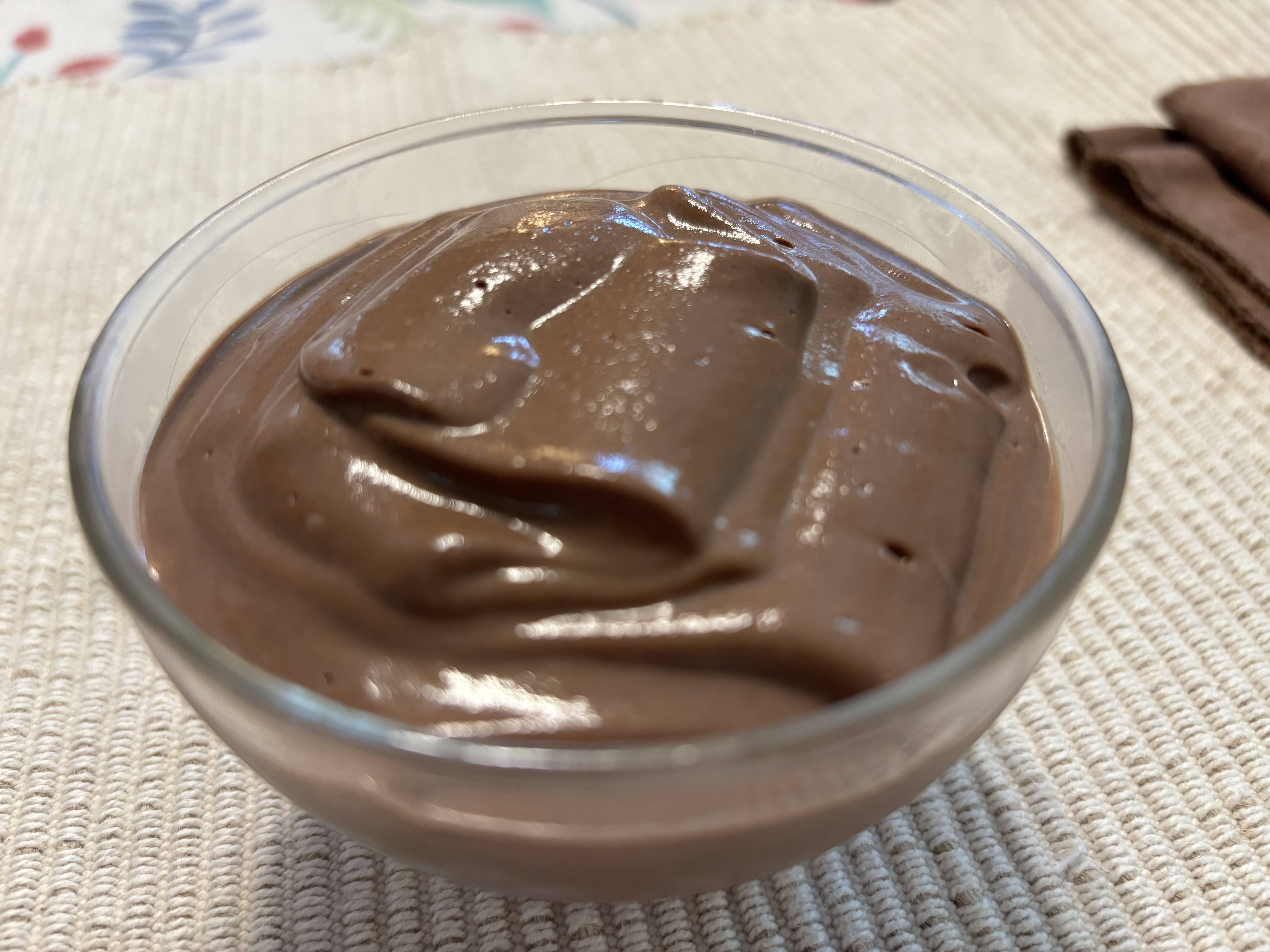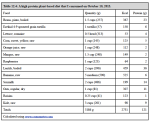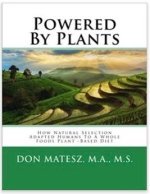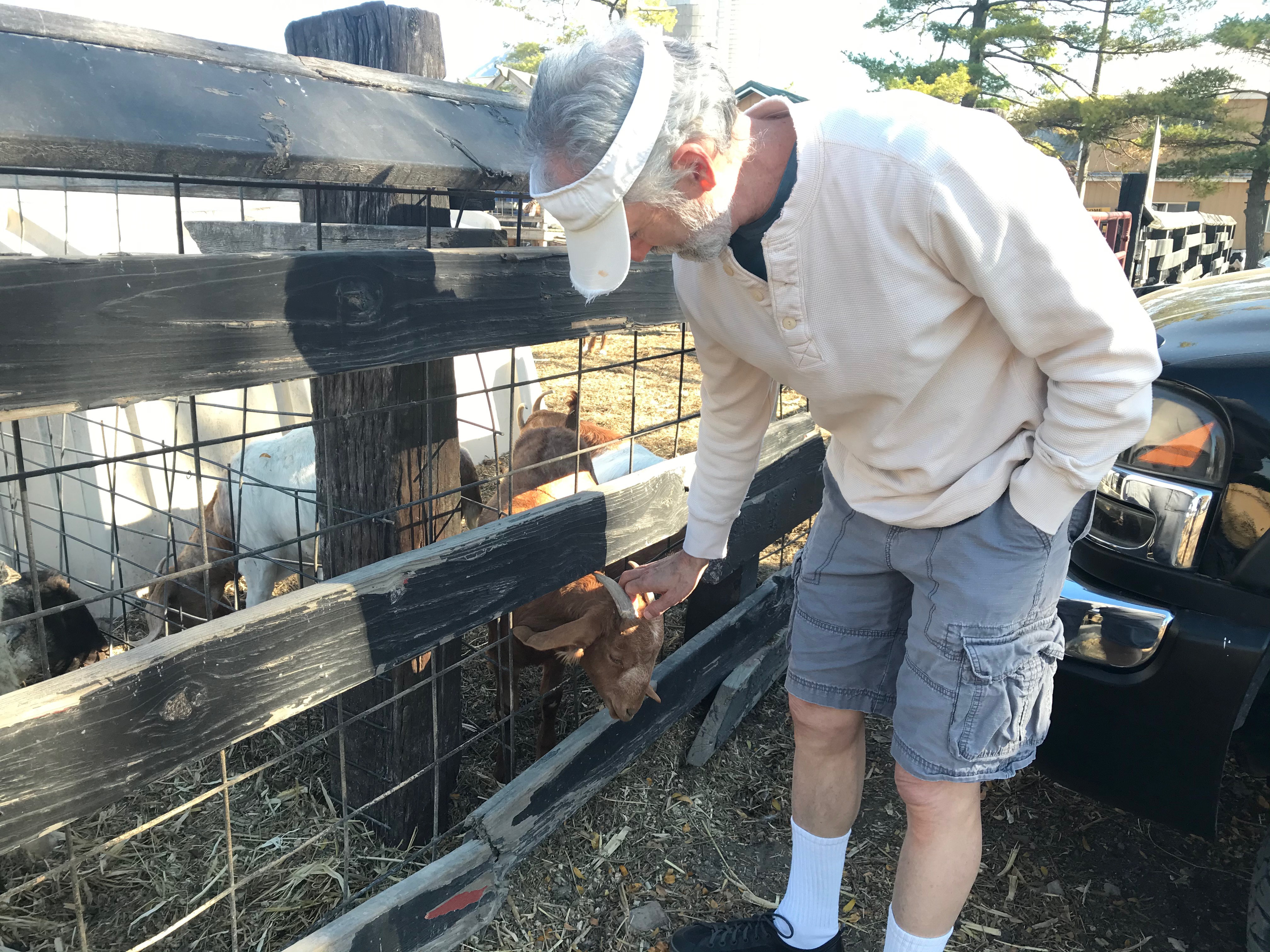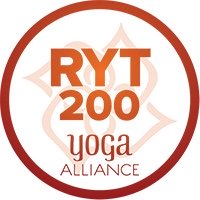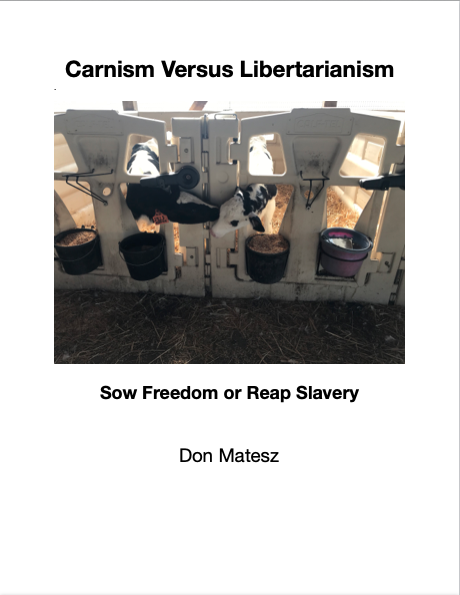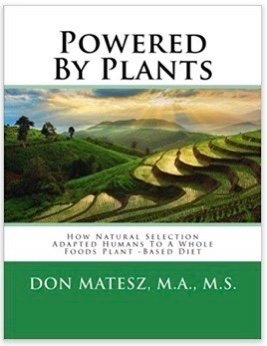Meta-review: A Plant-based Diet Is Best For Health Protection
When I published Powered By Plants back in 2013, I believed the preponderance of scientific evidence indicated that a plant-based diet is best for health promotion and recovery.
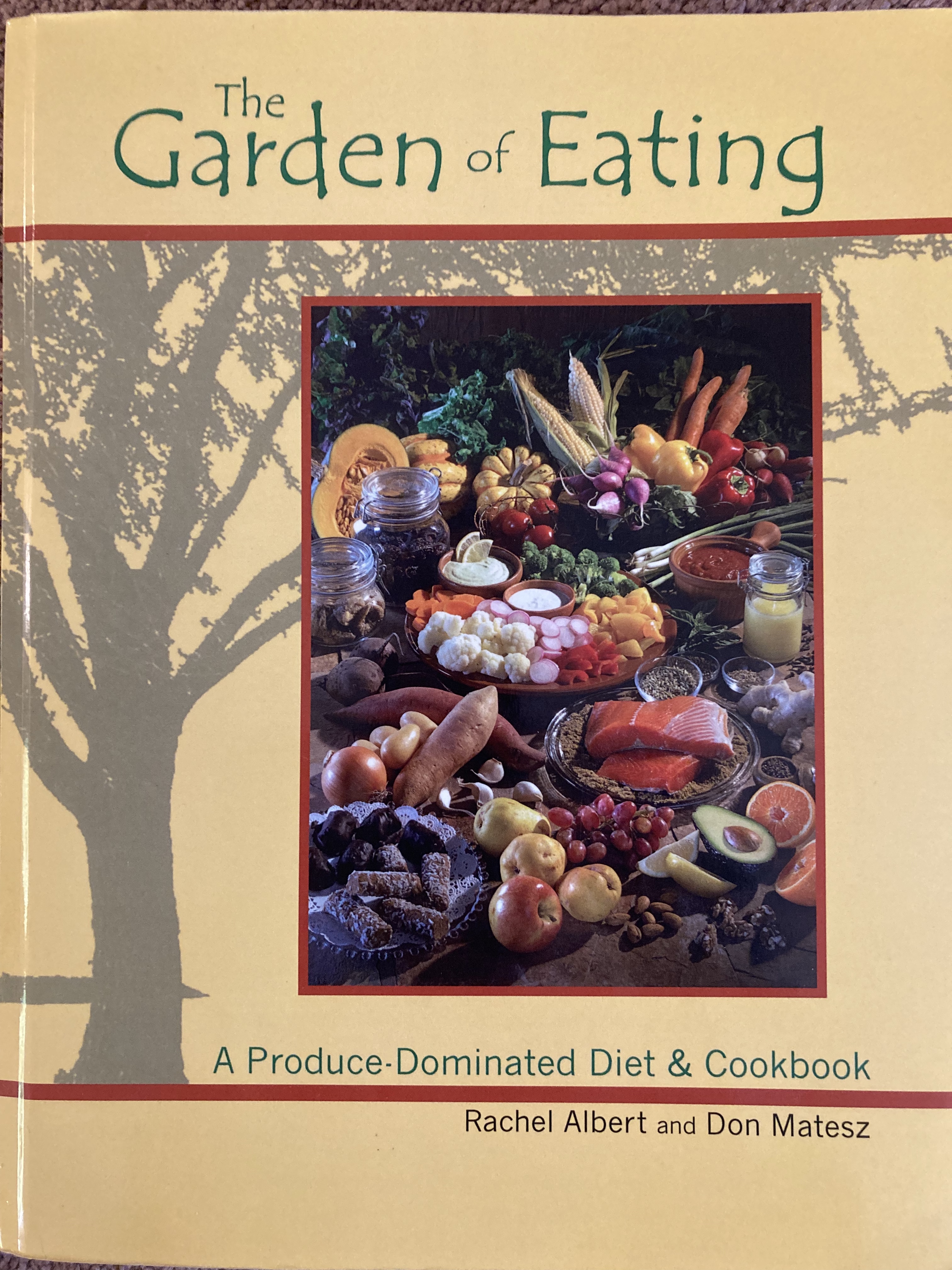 |
I came to that conviction after studying and experimenting with diet and nutrition and for more than 3 decades, during which time I had earned the equivalent of a bachelor's degree in human nutrition from the former American Academy of Nutrition. Before 2017, I was so convinced that of the importance of a plant-based diet that even when I ate a "paleo diet," I made sure it was a produce-dominated diet, consisting primarily of whole plant foods, as described by my first wife and I in The Garden of Eating: A Produce-Dominated Diet & Cookbook. |
|
The photo we chose for the cover of that book (to right) depicted what we ate and recommended: a diet that consisted primarily of plants by weight and volume. However, as I explained in the book, due to the low energy density of most fruits and vegetables and high energy density of meat and fat, meat and fat provided most of the energy (calories) of our pseudo-paleolithic diet. I argued that the typical contemporary hunter-gatherer diet was plant-based by weight/volume, but animal-based by energy (detailed explanation here). |
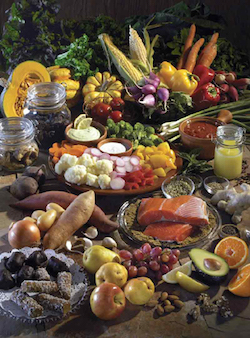 |
So, my ~5 year long adventure in the hypercarnivore direction (between 2017 and 2022) was a major departure from what I had understood and done for more than 35 years up to that point. During that highly carnivorous period, I gradually accumulated problems indicating that I was progressively increasing my risk of serious diet-related chronic disease. The problems started within 6 months with extremely high total and LDL cholesterol levels (total over 400 mg/dL at one point), followed by severe muscle cramping, and, eventually, among other more minor issues, the most alarming issue: chronic lower limb edema.
|
In 2022, after I obtained relief from chronic lower limb edema by resuming a primarily lactovegetarian whole foods plant based diet, I read Micheal Greger's How Not To Diet, from which I learned about a 2014 exhaustive meta-review of the large body of evidence that a whole foods plant-based diet is best for health protection (prevention of chronic diet-related diseases). Keep in mind that, in plain English, "plant-based" does not mean a diet composed exclusively of plants; just as "animal-based" does not mean a diet composed exclusively of animal products. |
"Whole food plant-based" means a diet composed primarily of plants, not a diet composed exclusively of plants. A diet composed exclusively of plants would be properly called an "exclusively plant food" diet.
This review provides evidence suggesting that neither an animal-based diet nor an exclusively plant food diet is best for prevention of diet-related chronic diseases (DRCDs). On the one hand, it presents compelling evidence that regular consumption of whole eggs, poultry, and red meat is likely to increase one's risk of diet-related chronic diseases, while on the other, it presents evidence that consumption of milk products or fish is more likely to reduce than increase one's risk of DRCDs.
Thus, this review suggests that the maximally prudent whole foods plant-based diet is not likely animal-based nor exclusively plant foods, but may be either lactovegetarian or pescatarian. I suggest that a lactovegetarian diet may have several important advantages over a pescatarian diet for people interested in achieving enlightenment and liberation from suffering.
NOTE: I am not claiming that this study proves beyond doubt that a whole foods plant based diet is best for health promotion. I only maintain that this study provides compelling evidence for the claim that a lactovegetarian or pescatarian whole foods plant based diet is best for health promotion.
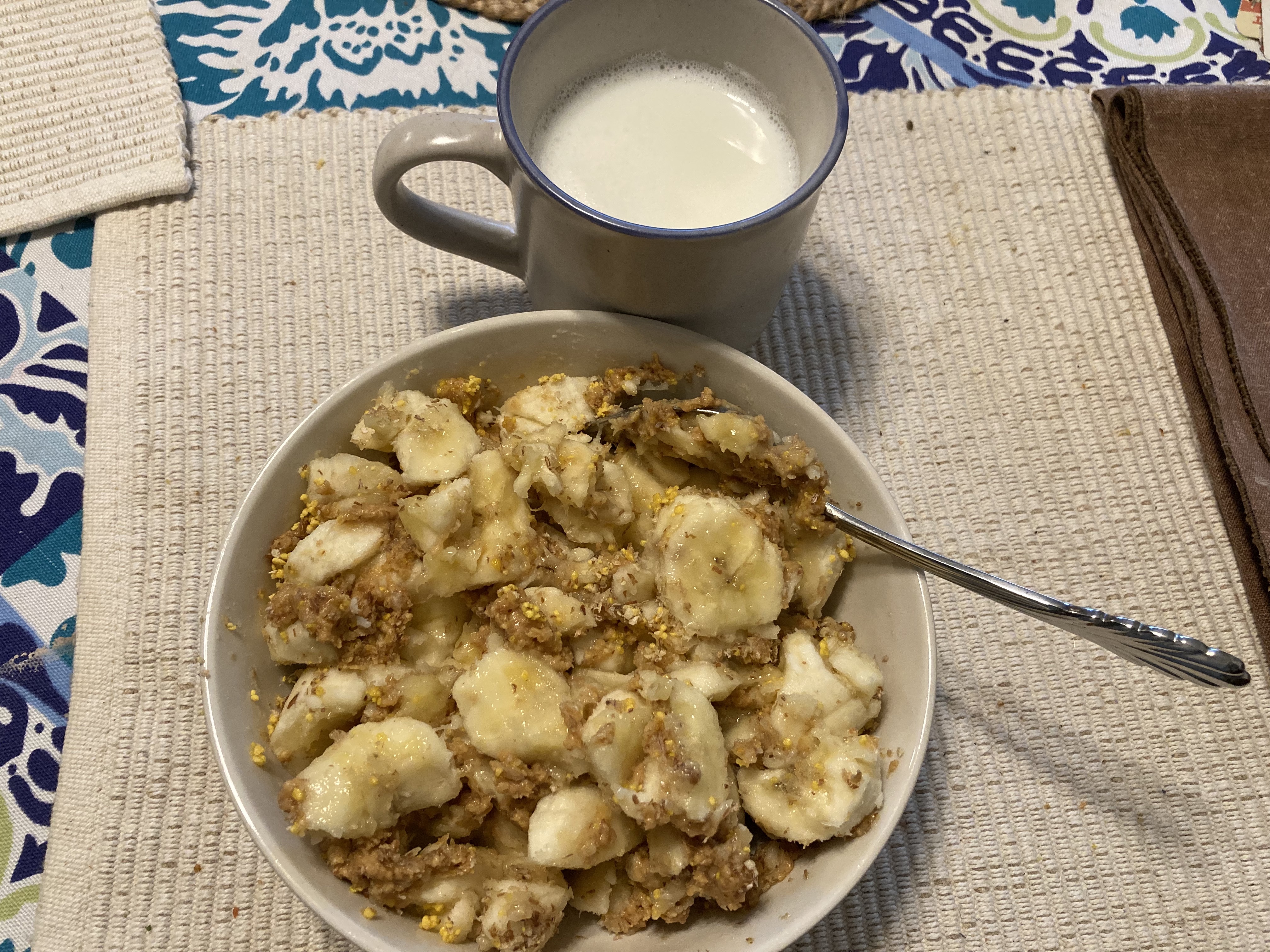
Bananas, peanut butter, flax seeds, lecithin, and milk for breakfast.
304 Large Studies Provide Evidence That A Whole Foods Plant-based Diet Is Best For Health
In 2014, the respected journal Nutrition Reviews published an exhaustive overview of 304 pooled/meta-analyses and systematic reviews (PMASRs) of associations between food and beverage groups and the risk of diet-related chronic diseases (DRCDs).
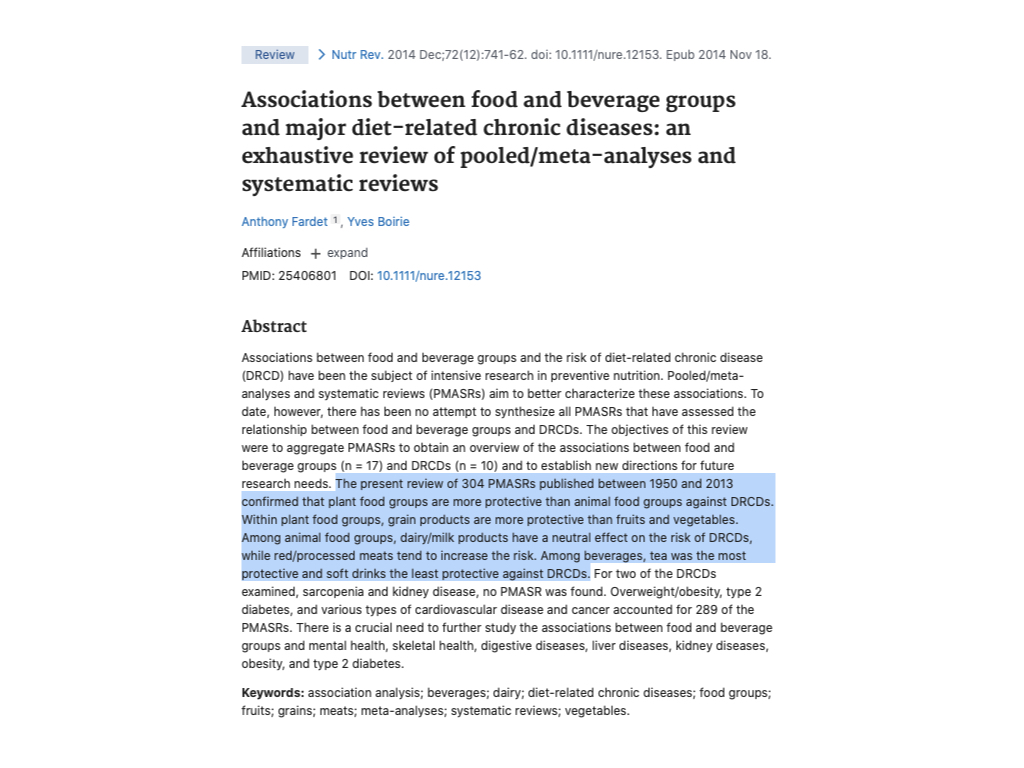
The authors of this peer-reviewed study reported no conflicts of interest. They reviewed 304 articles published between 1950 and August 31, 2013, which provided evidence linking foods and beverages to DRCDs including: obesity, type 2 diabetes, cardiovascular diseases (CVD), cancers, digestive diseases, mental illnesses, sarcopenia (muscle wasting), and some skeletal, kidney, and liver diseases.
It has been shown that these DRCDs originate from multiple factors, and may result from at least 10 different deregulated metabolic parameters, including:
- low antioxidant status
- acid-base imbalance
- elevated inflammation
- impaired carbohydrate, lipid, or one-carbon metabolism
- impaired neuron functioning
- impaired DNA transcription
- hypertension
- gut dysbiosis
Thus, a healthy diet must have a positive or at least neutral effect on most if not all of these systems, not only one or a few of them. This means we can't evaluate a diet (or single food) on only one or a few of these parameters, but must account for effects on all of these. For example, if a diet appears to improve body composition, fasting blood sugar and lipids but increases metabolic acidity or inflammation and kills off beneficial gut flora, it will not prevent DRCDs.
This meta-review of reviews and meta-analyses gives us an overview of the preponderance of scientific evidence. By studying the studies, we can get a view of the totality of evidence, rather than being focused on individual studies, each of which by itself might give us a misleading impression.
Whole Plant Foods Promote Health
This review of 304 other meta-analyses and reviews indicates that a whole foods plant based is best for health because the evidence from the 304 studies strongly indicates that whole grains, legumes, nuts, seeds, fruits and vegetables, the staples of a properly planned whole foods plant-based diet, promote health and prevent DRCDs.
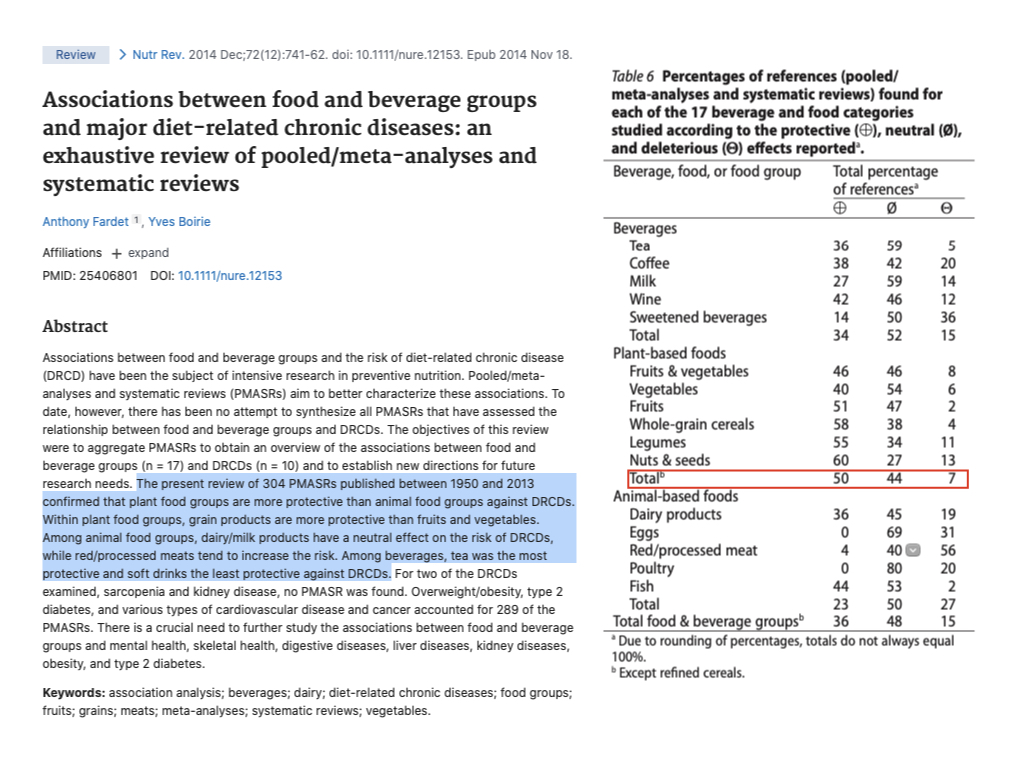
As shown above:
- Of studies of links between fruits and vegetables (considered together) and DRCDs, 46% reported a protective effect, 46% reported a neutral effect, and only 8% reported a negative effect. In other words, 92% of studies found a positive or neutral link between fruits and vegetables and DRCDs. Studies showing a protective effect of fruits and vegetables outnumbered those suggesting harm by nearly 6 to 1. This means that the preponderance of evidence indicates that fruits and vegetables either reduces or makes no difference in DRCD risk. This evidence supports the conclusion that a plant-based diet is best for health promotion if it includes plenty of fruits and vegetables.
- Of studies of links between vegetables and DRCDs, 40% reported a protective effect, 54% reported a neutral effect, and only 6% suggested a negative effect. In other words, 94% of studies found a positive or neutral link between vegetables and DRCDs. Studies showing a protective effect outnumber those showing harm by more than 6 to 1. Thus, there is little evidence that eating vegetables promotes DRCDs, but a preponderance of evidence that vegetables either reduces or makes no difference in DRCD risk.
- Of studies of links between fruits and DRCDs, 51% reported a protective effect, 47% reported a neutral effect, and only 2% suggested a negative effect. In other words, 98% of studies found a positive or neutral link between fruits and DRCDs. Studies showing a protective effect outnumber those showing harm by more than 25 to 1. Thus, there is little evidence that eating fruits promotes DRCDs, but a preponderance of evidence that eating fruits either either reduces or makes no difference in DRCD risk.
- Of studies of links between whole grain cereals and DRCDs, 58% reported a protective effect, 38% reported a neutral effect, and only 4% suggested a negative effect. In other words, 96% of studies found a positive or neutral link between whole grain cereals and DRCDs. Studies showing a protective effect of whole grains outnumber those showing harm by more than 14 to 1. Thus, there is little evidence that eating whole grain cereals promotes DRCDs, but a preponderance of evidence that eating whole grain cereals either either reduces or makes no difference in DRCD risk. This evidence supports the conclusion that a plant-based diet is best for health promotion if it contains plenty of whole grains.
- Of studies of links between legumes and DRCDs, 55% reported a protective effect, 34% reported a neutral effect, and only 11% suggested a negative effect. In other words, 89% of studies found a positive or neutral link between legumes and DRCDs. Studies showing a protective effect of legumes outnumber those showing harm by 5 to 1. Thus, there is little evidence that eating legumes promotes DRCDs, but a preponderance of evidence that eating legumes either either reduces or makes no difference in DRCD risk. This evidence supports the conclusion that a plant-based diet is best for health promotion if it includes plenty of legumes.
- Of studies of links between nuts and seeds and DRCDs, 60% reported a protective effect, 27% reported a neutral effect, and only 13% suggested a negative effect. In other words, 87% of studies found a positive or neutral link between nuts and seeds and DRCDs. Studies showing a protective effect of nuts and seeds outnumber those showing harm by about 5 to 1. Thus, there is little evidence that eating nuts and seeds promotes DRCDs, but a preponderance of evidence that eating nuts and seeds either either reduces or makes no difference in DRCD risk. This evidence supports the conclusion that a plant-based diet is best for health promotion if it includes plenty of nuts and seeds.
- Combining all studies linking any of the above whole plant foods to DRCDs, 50% reported a protective effect, 44% reported a neutral effect, and only 7% suggested a negative effect. In other words, 93% of studies found a protective or neutral link between whole plant foods and DRCDs. Studies showing a protective effect of whole plant foods outnumber those showing harm by more than 7 to 1.
Let's explore the whole plant foods data this way: If you were playing a game that was rigged so that you had a 50% (1 in 2) chance of benefit, a 44% (~4 in 10) chance of neither benefit nor harm, and only a 7% chance of being harmed, would you take the risk? I would. My chance of a benefit is more than 7 times my chance of being harmed, and my chance of benefit or neutral outcome is about 16 times my risk of being harmed.
It is important to note that this meta-review indicates that DRCDs are prevented not by one food group (e.g. vegetables) or macronutrient ratio (e.g. low fat), but by a dietary pattern, namely a whole foods plant based dietary pattern.
Thus, the preponderance of evidence gathered during the more than 60 years between 1950 and 2013 indicates that a whole foods plant based diet is best for reducing your DRCD risk.
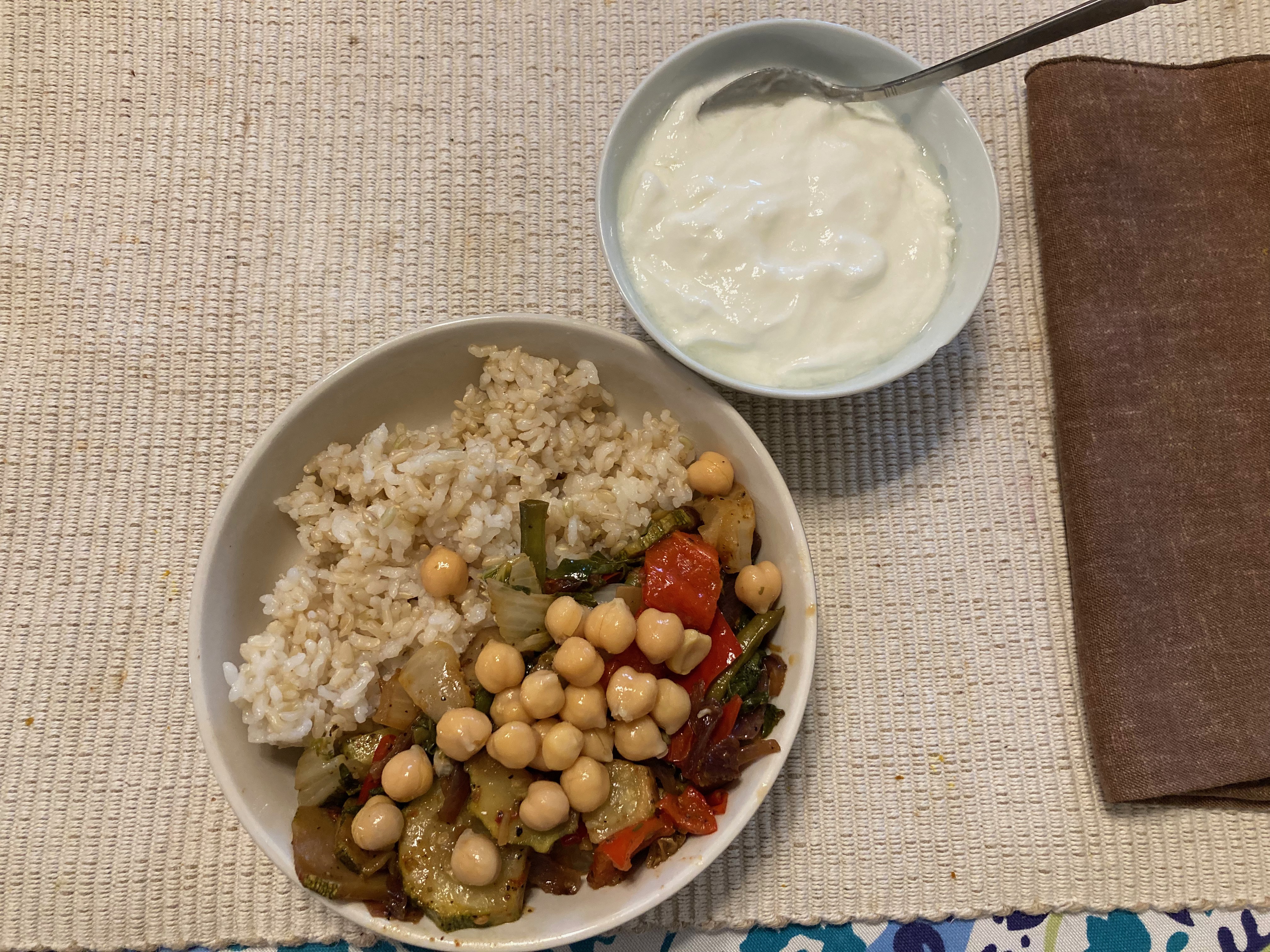
Brown rice, chickpeas and vegetables, yogurt.
The authors of this study noted that, contrary to common belief and expectation, the evidence does not show that fruits and vegetables offer more protection against DRCDs than whole grains, legumes, nuts and seeds. On the contrary, diets rich in whole grains, legumes, nuts and seeds appear to offer greater protection against DRCDs than fruits or vegetables.
Let's quickly review why.
- 46% of studies found fruits and vegetables combined to be protective
- 40% of studies found vegetables to be protective
- 51% of studies found fruits to be protective
- 58% of studies found whole grains to be protective
- 55% of studies found legumes to be protective
- 60% of studies found nuts and seeds to be protective
From this the evidence for a protective action of whole grains, legumes, and nuts and seeds appears stronger than the evidence for a protective action of fruits and vegetables. Note also that the evidence that fruit is protective appears stronger than the evidence for vegetables being protective.
On this basis, it would seem that a whole foods plant based diet is best for health promotion and disease prevention when it emphasizes whole grains, legumes, nuts and seeds. Consequently, the authors wrote:
|
"The exhaustive literature did not provide strong evidence of the protective effects of fruits and vegetables, which contradicts the general widespread belief that fruits and vegetables are very healthful. The most convincing tendency was for a protective effect of fruits against CVD risk. The results clearly showed that fruit and vegetable intake does not increase the overall prevalence of DRCDs...More conclusive results have been obtained with grain-based food groups, which appear to be protective against overweight/obesity, type 2 diabetes, CVD, and cancers...If whole-grain cereals tend to be protective, refined cereals appear to be either neutral or harmful, especially toward type 2 diabetes. Legumes appear to be a promising food group...legumes may be particularly protective against cancers. The protective effect of nuts and seeds against CVD risk and, to a lesser extent, diabetes risk, is rather convincing." [....] "Therefore, on the basis of these results, greater emphasis should be placed on grain products in food pyramids, first on whole-grain cereals and leguminous seeds, and then on nuts and seeds. Grain products show promise as foods with a potential to reduce DRCD risk, most likely even more so that fruits and vegetables. Even more compelling, grain products are a superior source of energy (based on starch content, especially whole-grain cereals), proteins (especially leguminous seeds), and lipids (especially nuts and oleaginous seeds) and are less expensive and easier to store than fruits and vegetables." |
Thus, this body of evidence suggests that I was on the wrong track when I thought that the best diet was a pseudo-paleolithic or "meats and sweets" diet that includes vegetables and/or fruits but excludes whole grains and legumes. This body of evidence contradicts the "paleolithic diet" idea that we are not adapted to eating whole grains and legumes, and argues against ditching whole grains and legumes in favor of fruits, vegetables and meat.
Milk and Dairy Products Probably Beneficial
In support of the thesis that a lactovegetarian whole foods plant based diet is best for health promotion, this meta-review indicates that milk and dairy products probably do not promote DRCDs and are more likely to provide benefit than cause harm.
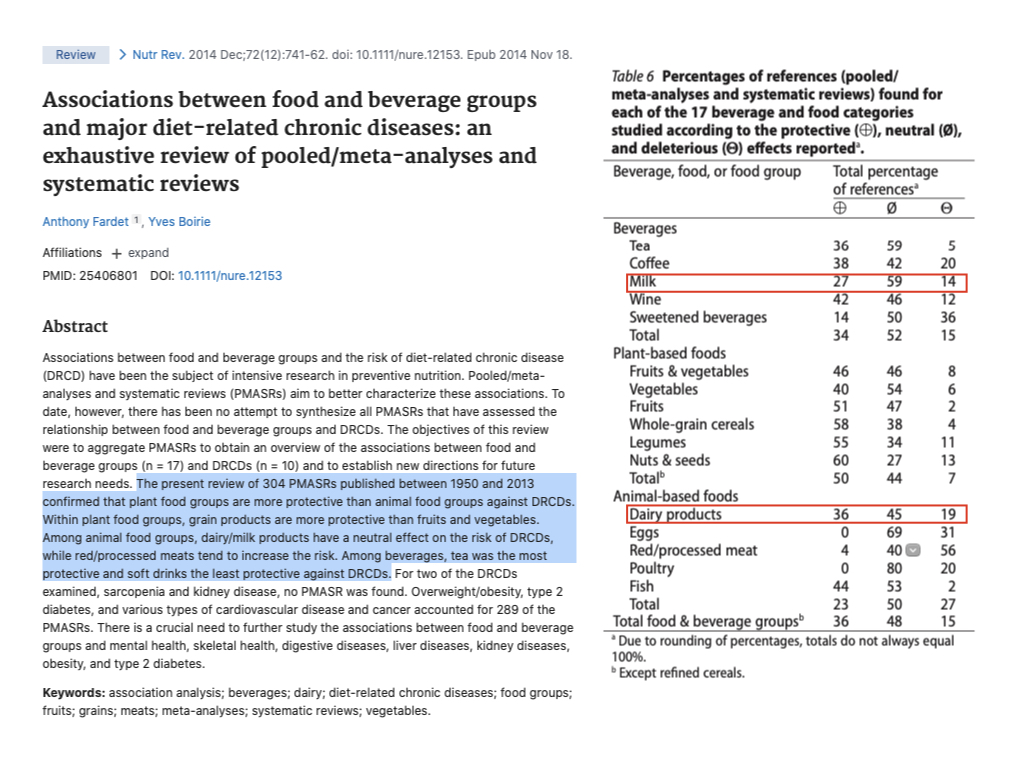
As shown in the table 6 from this study:
- Of studies of links between milk (whole or reduced fat) and DRCDs, 27% reported a protective effect, 59% reported a neutral effect, and 14% suggested a negative effect. In other words, 86% of studies found a positive or neutral link between milk and DRCDs, and studies showing milk protective outnumbered studies showing it harmful by nearly 2:1. Thus, it appears that the preponderance of evidence suggests that using milk either reduces or makes no difference in DRCD risk.
- Of studies of links between dairy products (whole or reduced fat) and DRCDs, 36% reported a protective effect, 45% reported a neutral effect, and 19% suggested a negative effect. In other words, 81% of studies found a positive or neutral link between dairy products and DRCDs, and again, studies showing a protective effect outnumbered those showing a negative effect by nearly 2:1. Since studies showing a neutral or positive effect of consuming dairy products outnumber those showing a negative effect by 4:1, it appears that a preponderance of evidence favors that using dairy products either reduces or makes no difference in DRCD risk.
Let's explore the milk data this way: If you were playing a game that was rigged so that you had a 27% chance of benefit, a 59% chance of neither benefit nor harm, and a 14% chance of being harmed, would you take the risk? Your chance of a benefit is nearly 2 times your chance of being harmed, and your chance of benefit or neutral outcome is about 6 times your risk of being harmed.
Let's explore the total dairy product data the same way: If you were playing a game that was rigged so that you had a 36% chance of benefit, a 45% chance of neither benefit nor harm, and a 19% chance of being harmed, would you take the risk? Your chance of a benefit is again nearly 2 times your chance of being harmed, and your chance of benefit or neutral outcome is about 4 times your risk of being harmed.
Thus, the preponderance of evidence gathered between 1950 and 2013 probably indicates that eating milk or dairy products is more likely to reduce or have no effect on your DRCD risk than to increase that risk.
On the basis of this evidence, the authors state:
|
"....the results from the present analysis showed that regular and/or high consumption of milk has a rather neutral effect, i.e., it is not associated with major DRCD risks. In other words, scientifically speaking, drinking milk should not be discouraged, contrary to what might be read or heard within various media today." (bold added) |
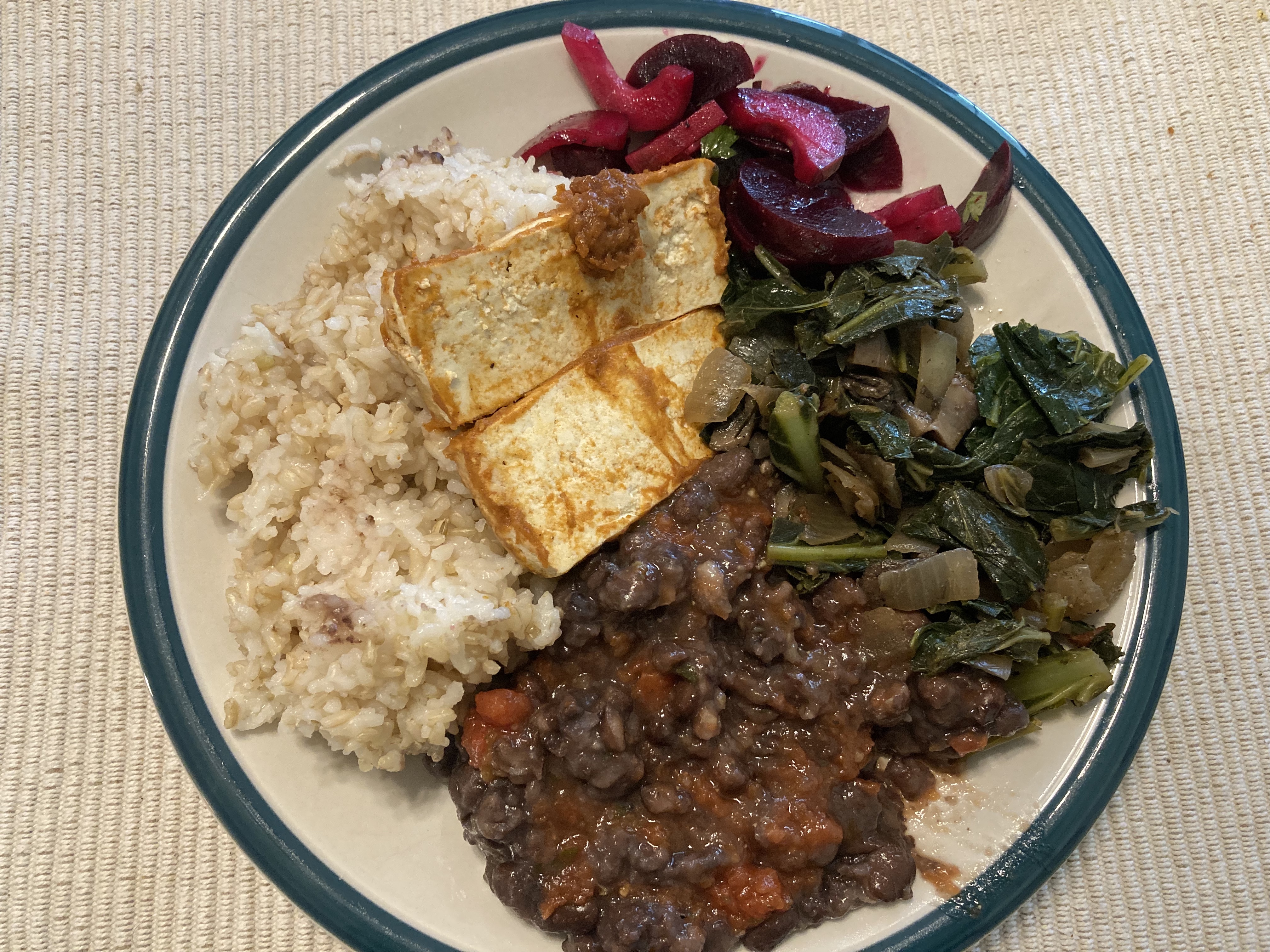
A delicious vegetarian meal: brown and white rice; black beans with salsa; onions, mushrooms, tomatoes and collards stir-fried in ghee; beet salad; tofu baked in apple barbecue sauce.
Fish Also Appears Beneficial
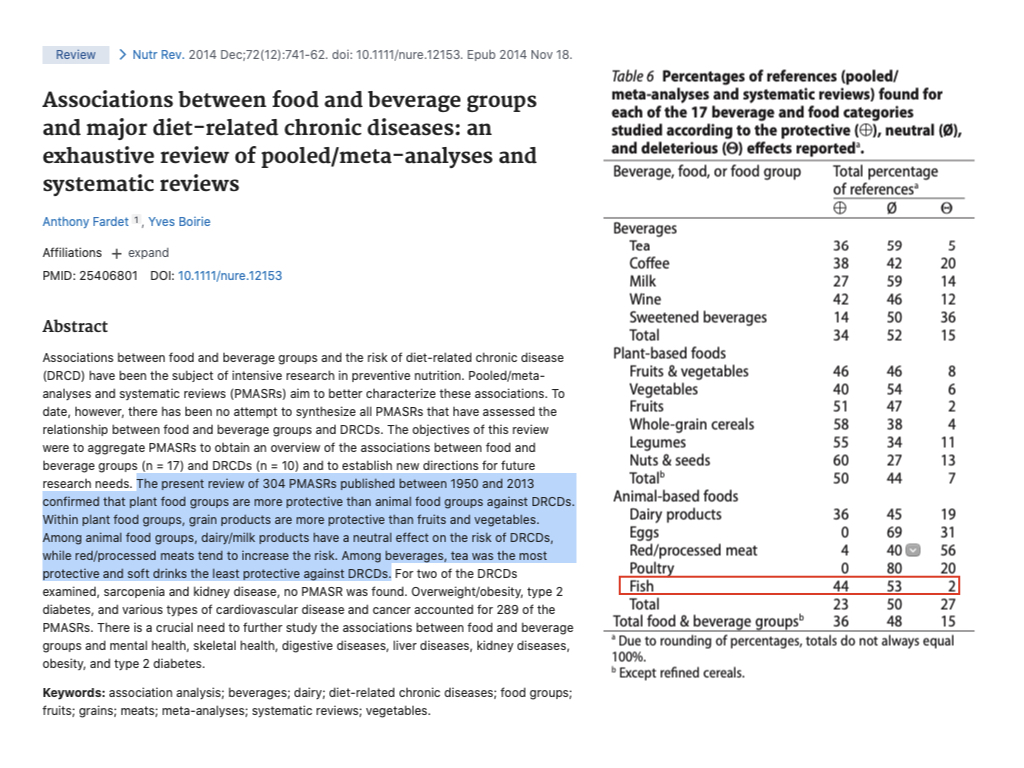
This review found that of studies of links between fish intake and DRCDs, 44% reported a protective effect, 53% reported a neutral effect, and 2% suggested a negative effect. In other words, 97% of studies found a positive or neutral link between fish intake and DRCDs. Thus, there is very little evidence that eating fish promotes DRCDs, and a preponderance of evidence indicates that eating fish either reduces or makes no difference in DRCD risk.
If you were playing a game that was rigged so that you had a 44% chance of benefit, but only a 2-4% (1 in 50 to 1 in 25) chance of being harmed, would you take the risk? Your chance of a benefit is at least 11 and up to 22 times your chance of being harmed.
Thus, this study suggests it is unlikely that adding some fish to a predominantly (e.g. ≥85%) whole foods plant based diet would increase one's risk of any DRCD. On the contrary, on this evidence alone it is more likely that adding fish would reduce your risk.
Meat, Eggs and Poultry Appear Likely To Be Harmful
This review of 304 other studies appears to indicate that the whole foods plant based diet is best for health because the authors found that consumption of meat, eggs, and poultry very likely increases one's risk of DRCDs.
Let's focus on eggs first.
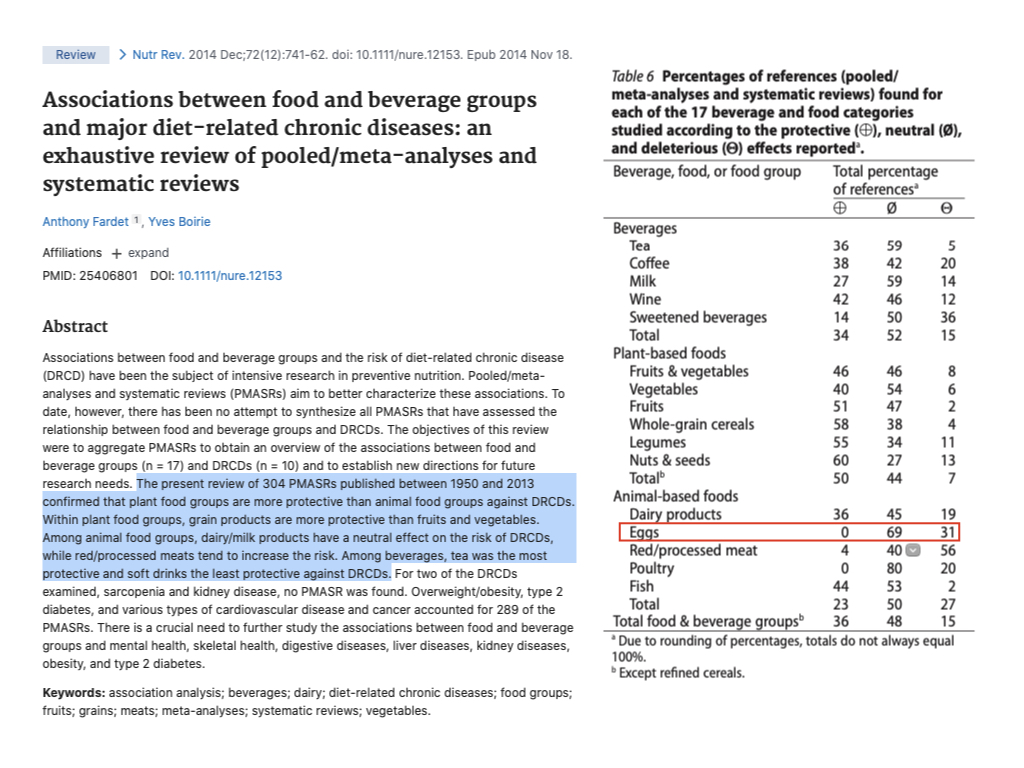
This review found that of studies of links between egg intake and DRCDs, 0% reported a protective effect, 69% reported a neutral effect, and 31% suggested a negative effect. Thus, the authors found no evidence that eating eggs protects against any of the DRCDs, and that a preponderance of evidence indicates that eating eggs either increases or makes no difference in DRCD risk.
The absence of any evidence for a protective action of eggs suggests that, in respect to DRCDs, there is no benefit to eating eggs while there is probable risk. Thirty-one percent of studies on egg consumption show a probable harm. If you were playing a game that was rigged so that you had no chance of winning anything, but a 31% (almost 1 in 3) chance of being harmed, would you take the risk?
Some research reports that regular consumption of egg yolks accelerates atherosclerosis at a rate of about two-thirds of the effect of smoking, and in diabetics one egg per day increases risk of cardiovascular events by two to five fold! That level of relative risk associated with egg consumption indicates there's likely a real causal link between egg intake and progression of atherosclerosis.
Knowing now that whole eggs present this level of risk I wouldn't want to eat 1 or more whole eggs daily. Since the risks associated with egg consumption have been primarily linked to egg yolks (saturated fats, cholesterol, choline), one probably can reduce or minimize the risk of egg consumption by limiting or avoiding eating yolks. I wouldn't worry about occasionally getting fractions of an egg yolk here and there in mixed foods (e.g. occasional whole grain pancakes), but I would strive to exclude whole egg yolks and favor using egg whites or, probably better, plant-based egg substitutes.
Now let's focus on poultry.
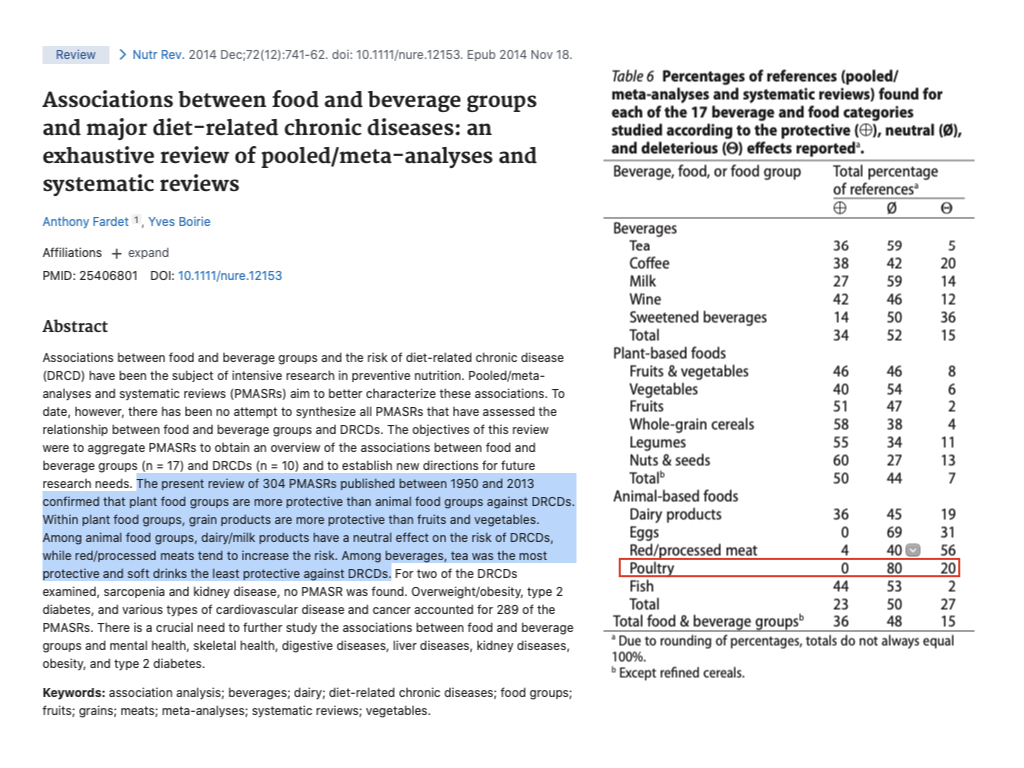
This review found that of studies of links between poultry intake and DRCDs, 0% reported a protective effect, 80% reported a neutral effect, and 20% suggested a negative effect. Thus, there is no evidence that eating poultry protects against any of the DRCDs, and a preponderance of evidence indicates that eating poultry either increases or makes no difference in DRCD risk.
The absence of any evidence for a protective action of poultry suggests that eating poultry probably provides no protection against DRCDs. On the other hand, there is probable risk. Twenty percent of studies found evidence that eating poultry may increase one's risk of DRCDs.
If you were playing a game that was rigged so that you had no chance of winning anything, but a 20% (1 in 5) chance of being harmed, would you take the risk?
Finally let's focus on the red and processed meats.
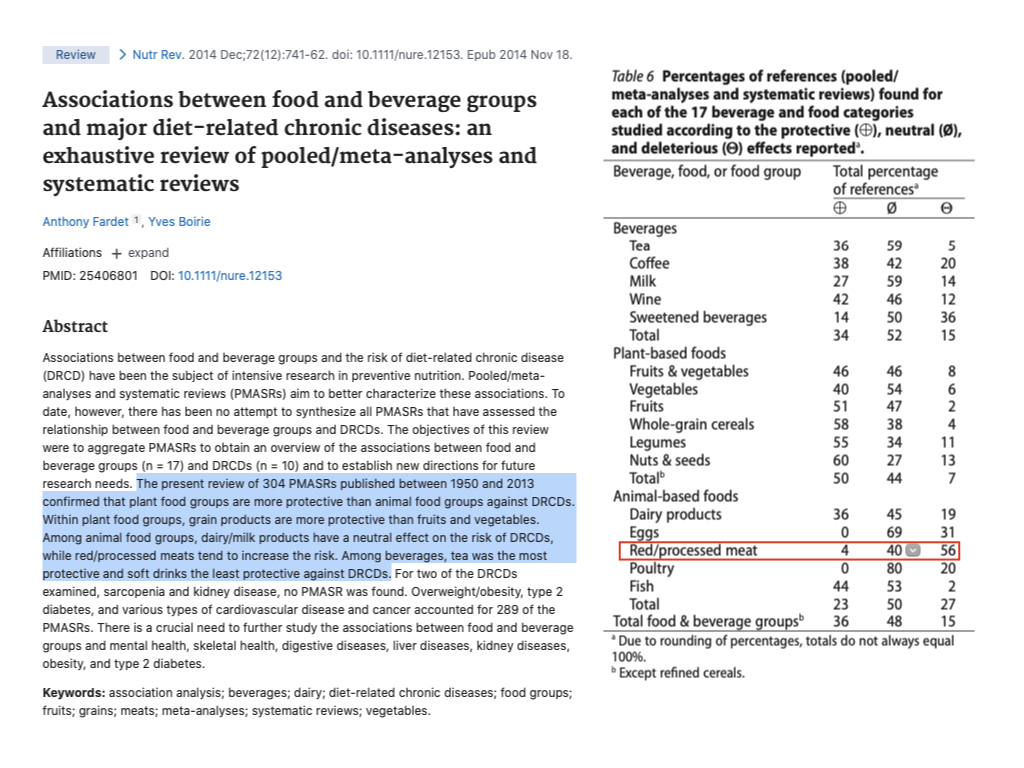
This review found that of studies of links between red or processed meat intake and DRCDs, 4% reported a protective effect, 40% reported a neutral effect, and 56% suggested a negative effect. Thus, there is very limited evidence that eating red or processed meat protects against any of the DRCDs, and the majority of evidence (more than 50%) indicates that eating red or processed meat increases DRCD risk.
Red meat contains multiple potential bad actors:
- Animal protein increases risk of chronic kidney disease and (raises LDL independent of saturated fat) https://pubmed.ncbi.nlm.nih.gov/3097105/
- High level of heme iron (also present in dark poultry meat) which appears to promotes oxidative stress & inflammation: https://pubmed.ncbi.nlm.nih.gov/25439662/
- High phosphorus, unopposed by calcium, which is linked to disordered mineral metabolism, vascular calcification, bone loss, and impaired kidney function: https://pubmed.ncbi.nlm.nih.gov/24038251/
- Neu5Gc, which appears to promote chronic inflammation and cancer: https://pubmed.ncbi.nlm.nih.gov/25548184/
If you were playing a game that was rigged so that you had a 4% (1 in 25) chance of winning anything, but a 56% (better than 1 in 2) chance of being harmed, would you take the risk?
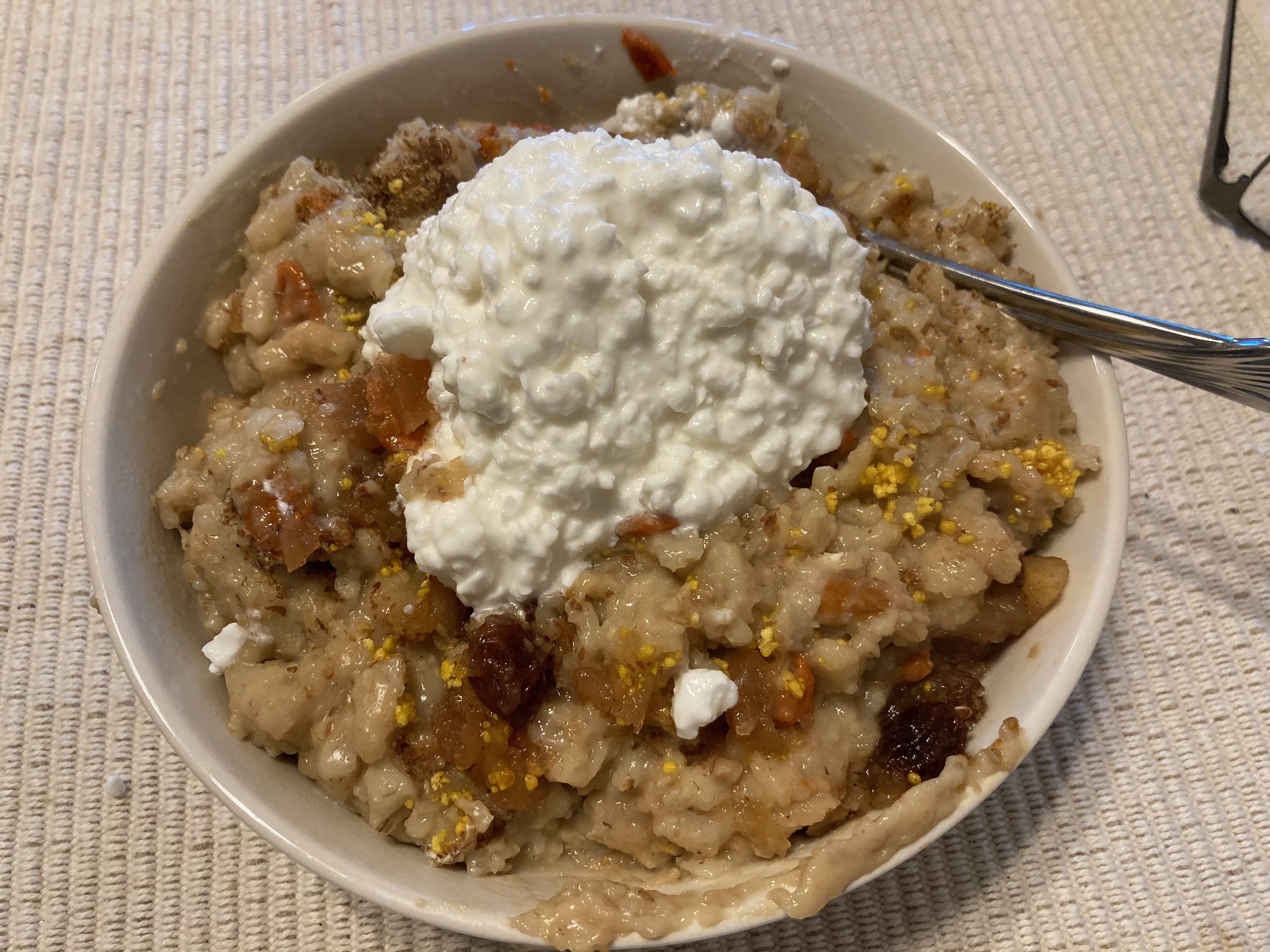
Oatmeal, barley flakes, goji berries, stewed apples & raisins, topped with ground flax seed, soy lecithin, and unsalted 1% fat cottage cheese.
Dose Makes The Poison
It bears repeating that although the authors of this meta-review concluded that a whole foods plant-based diet is best for health protection and promotion, the authors didn't conclude that an exclusively plant food diet is best. They wrote:
|
"If animal-based food group consumption is associated with a less protective effect, it must be kept in mind that all results are derived from PMASRs based on the comparison of the highest versus the lowest consumer. Thus the results do not mean that no animal-based food group should be consumed, rather that individuals with the highest level of consumption should restrict their consumption, and conversely, those with the lowest consumption of plant-based food groups should increase their consumption. Therefore, the results of this analysis are, overall, in agreement with food-based pyramids, except that all grain products should probably be emphasized over fruits and vegetables, rather than the reverse." |
So, they didn't recommend avoiding all animal products, but did recommend that individuals "with the highest level of consumption" should reduce their consumption of animal products. On the other hand, those with the lowest consumption of whole plant foods should increase their consumption.
We have some evidence that one might be able to occasionally consume some types of poultry or red meat without increasing one's risk of DRCDs if one a) consumes adequate amounts of whole plant foods and b) limits the amount and fat content of the poultry or meat consumed. For example:
- The Pritikin Center has published more than 100 studies on participants in their residential program showing significant reductions of chronic disease activity or risk factors as a consequence of consumption of the Pritikin Diet, which is a whole foods plant based diet that allows for 2 daily servings of non-fat milk products, 2 egg whites (no yolks), 200 g of fish per week, and, up to 100 g weekly of crustaceans (shrimp, crab, lobster), skinless white meat poultry, or very lean game meat (bison, venison, elk), so long as total diet fat content is kept below 10% of energy.
- This epidemiological study found that people aged 55 and older who consumed more than 500 g of red meat per week had no increased risk of cancer compared to those who consumed less than 250 g per week IF they also consumed 5-6 servings of vegetables and fruits and, in women, at least one serving of whole grains daily. In this study, the men consumed a mean of 461 g and a maximum of 809 g of red meat per week, which is only 65-116 g (2-4 ounces) daily, and the women consumed a mean of only 263 g and a maximum of 455 g per week, which is only 38-65 g (1.4-2.3) ounces per day. Thus, this study suggests that IF one consumes 5-6 servings of vegetables and fruits and at least 1 serving of whole grains daily AND limits red meat to less than 116 g per day (about the size of a deck of cards), then one might avoid the increased risk of cancer associated with red meat intake.
On the other hand, the evidence presented in the meta-review suggests that whereas neither eggs, poultry or red meat has been associated with reduced risk of DRCDs in any study, multiple studies suggest that eating fish or using milk and dairy products may actually reduce one's risk of DRCDs.
This suggests that the maximally prudent diet would eliminate the potentially risk-elevating egg yolks, poultry and red and processed meats, but retain the potentially risk-reducing milk products or fish or both.
One could argue that either a lactovegetarian and a pescatarian whole foods plant based diet is best as either would have a favorable risk:benefit ratio, since one is more likely to be helped than harmed by either milk/dairy products or fish consumption.
What Makes A Diet Vegetarian?
Although a diet composed primarily of whole plant foods with a supplemental amount of fish would not fit the usual definition of a vegetarian diet, in his excellent book Transition to Vegetarianism, Rudolph Ballentine, M.D. makes an important point:
|
"The origin of the term 'vegetarian' can be traced to the Latin vegetare, which means 'to enliven.' This is related to vegere and vigere, which mean 'to arouse' and 'to flourish.' From the latter also come 'vigorous' and 'vigil,' which connotes wakeful or alert. The most ancient root word is wag, to be lively or strong. The basis of the term 'vegetarian' then, is a sense of liveliness, vigor, and alertness, rather than merely an indication of a diet of vegetables. The issue is not whether the diet is or isn't made up exclusively of foods of plant origins (vegetable foods) but whether it is enlivinening and health-giving. What is used as a supplemental source of protein and other nutrients, be it milk, eggs, fish, or even fowl or meat, is a less important consideration." |
Since "whole foods plant-based" does not mean "composed exclusively of plants," if a whole foods plant-based diet is best for health, what is the best source of supplemental animal-source nutrition for those who want to maximize vigor and alertness?
I think there are several reasons in favor of using milk products rather than fish, poultry or meat to supplement a whole foods plant based diet.
The Vegetarian Plant-Based Diet Is Best For Reducing Your Food Costs
In the region where I live, a half gallon of high quality locally produced milk costs about $3.40. On a lactovegetarian diet one would consume a pint of milk or yogurt daily, which would cost $0.85.
In contrast, a pound of locally caught perch from the Great Lakes costs $28.99/lb. Just 1/4 pound of this daily would cost $7.24. Generally, 100 g of good quality poultry and red meat will also be more expensive than a pint of milk.
The Lactovegetarian Plant-Based Diet Is Best For Ensuring Nutrient Adequacy
Without supplementation, a diet composed exclusively of whole plant foods (commonly known as a vegan diet) tends to be inadequate in some key nutrients. It may lack total protein or be somewhat limited in certain amino acids (such as leucine) due in part to the significantly lower digestibility of plant proteins compared to animal proteins. A diet composed exclusively of whole plant foods (i.e. a vegan diet) also tends to lack adequate amounts of vitamins B2 and B12, calcium, iodine, and zinc [source].
With this in mind, supplementing a whole foods plant based diet with a daily pint of milk or yogurt appears nutritionally superior to using a calorically comparable serving of fish, poultry or meat in several important respects.
Protein: The biological value (BV) of protein is a measure of the efficiency of a protein in meeting human needs, expressed as a percentage of the nitrogen absorbed that is retained for growth and maintenance. The BV of milk protein is 93, second only to whole egg, whereas the BV of fish is only 75 (the same as beef). Therefore milk is superior to fish, poultry or meat as a supplemental protein for a plant-based diet.
Riboflavin (B2): A pint of 2% milk supplies 0.9 mg or 53% of the daily requirement of riboflavin, whereas 5 ounces of salmon supplies only 0.7 mg or 41% of the requirement and 8 ounces of cod supplies only 0.2 mg of 11% of the requirement. Milk is also superior to poultry and red meat in riboflavin content.
Cobalamin (B12): A pint of 2% milk provides 2.59 mcg of vitamin B12, which is more than the recommended intake of 2 mcg. A single serving of fish will also supply more than the recommended intake of vitamin B12.
Calcium: A pint of 2% milk supplies 244 kcal and 551 mg calcium protein, whereas 5 ounces of salmon supplies a comparable 257 kcal but only 21 mg calcium, and 8 ounces of cod (238 kcal) supplies only 32 mg calcium. Poultry and red meat are also poor sources of calcium.
Iodine: Although it is well-known that seafood supplies iodine, few people know that a pint of 2% milk supplies 178 mcg of iodine, 119% of the recommended intake. Poultry and lean beef are poor sources of iodine.
Zinc: A pint of 2% milk supplies 2 mg of zinc, 16% of the recommended intake, whereas 5 ounces of salmon or 8 ounces of cod supplies only about 1 mg. Thus milk supplies about twice as much zinc per calorie. Meat is superior to either milk or fish as a zinc source, but if one consumes adequate properly prepared (i.e. well cooked) whole grains and legumes, one will not need meat as a source of zinc, as I showed in my comparison of nutrients supplied by a carnivore and a lactovegetarian diet.
The Lactovegetarian Plant-Based Diet Is Best For Avoiding Food-Borne Contaminants
Both wild and farmed fish flesh is likely to be subject to environmental contaminants due to pollution. Since farmers control dairy cow diets, the milk is more easily kept free of pollutants.
The problem with using fish as a staple source of B12 or iodine is that authoritative sources such as the EPA recommend that adults limit fish intake to to only 8-12 ounces (2-3 servings 4 ounces each) per week due to the potential for excessive exposure to mercury and other environmental contaminants. Children are advised to limit fish to even smaller servings (1-3 ounces depending on age).
Fish carries other environmental contaminants of serious health concern.
For example, research indicates that it is not safe to consume fish from Lake Erie (nearest to me) more than once weekly. This is due to the fish containing a hepatotoxin accumulated from cyanobacteria. These fish also contain:
Since it is not safe to eat more than 8-12 ounces of fish weekly due to these contaminants, one will obtain greater nutritional benefits with far less risk from use of a pint of good quality milk or yogurt daily.
For example, consuming 8 ounces of fish weekly would provide about 60-70 g of animal protein per week or about 10 g per day, whereas consuming a pint of milk daily would provide 16 g of animal protein daily, 60% more than provided by the fish, at a lower cost. Furthermore, as noted above, milk protein is superior to fish protein.
A Plant-Based Diet Is Best For Practicing Ahimsa
The principle of ahimsa, or non-harming, comes from the yoga tradition of Sanatana Dharma.
Many if not most people believe that the principle of non-harming or non-violence is primarily a moral imperative to avoid injuring others. Although the ahimsa principle does guide us to avoid harming others, it also guides us to avoid harming ourselves.
While it is commonly claimed that we can harvest milk from cows without abusing or killing the cow or calf, in actual practice this really is false; it is impossible to get milk from a cow without making her pregnant, then separating the cow from her calf, and depriving the calf of both its birthright food and contact with its mother; finally, 50% of calves are male, and in practice they are killed for veal or beef. Of course, we can't eat fish, poultry or red meat without killing fish, birds or mammals.
Thus, although it may seem that the lactovegetarian plant based diet is best for minimizing the taking of animal lives, in comparison to a meat-eating diet, in practice there is little difference.
In the yoga tradition, the practice of ahimsa includes relieving oneself of unnecessary physical, mental, emotional and spiritual burdens so as to produce a literal enlightenment, a lightening up of the body, mind and spirit.
In this regard, Ballentine remarks:
|
"It might also be maintained that supplemental foods come to dominate and transform a diet if they have negative effects on consciousness. If the physiological effects of a relatively small amount of meat are such that they stimulate a pointless hostile aggressiveness or a chronic low level of fear and anxiety, one might feel justified in concluding that the diet has lost its vegetarian essence and that it is no longer appropriate to apply that term to it." |
In short, a man seeking his own enlightenment and liberation from bondage and suffering is concerned not only with the impact his actions may have on others, but also the impact his actions will have not only on his own body, but also on his mind and consciousness.
Ballentine, a physician and psychiatrist, explains:
|
"Though the modern shopper picking up a neatly wrapped package of meat from a supermarket display case might feel quite remote from feedlots and slaughterhouses, the origin of his food is not unknown to him, and Eastern concepts of psychological functioning which see each action as bringing into the unconscious mind a whole set of consequent associations and images are not out of keeping with more modern ideas of how the mind works. From this perspective the mental field would become progressively cluttered with the reverberations of eating habits that require the abuse and slaughter of animals. Such psychological and emotional effects would, on some level, and to some extent, dissipate mental energy and distract attention, and would as a result be considered a handicap and a hindrance to full alertness and clarity of consciousness. One aspect of the philosophies on which such psychological insights are based is the priority given to clarity of consciousness. It is seen not only as a prerequisite to the discovery of the aim of one's life, but also as critical for the attainment of such an aim. "Through painstaking and persistent self-scrutiny the sages of ancient times catalogued those influences that could distract and disrupt consciousness. Flesh foods aroused the animal instincts of aggression and fear, they concluded. On the other hand, milk and eggs (at least those not fertilized) created different effects. They are nourishment given to the young. They do not require the taking of life; their essence is, on the contrary, the giving of life." |
While it is technically true that harvesting milk does not require the taking of life when "taking life" is narrowly defined as killing someone, it certainly does require taking liberty and property from someone (cow and calf), and in practice farmers kill the some of the male calves for veal, castrate and raise the rest of the male calves as steers for beef, and kill all the females for beef (mostly ground beef) after the farmers have milked them for all they can produce. Therefore, people interested in practicing non-violence in diet should really avoid dairy products as well as eggs, fish, poultry and meat. A vegan whole foods plant based diet is best for practicing ahimsa.
Some readers may find the suggestion of a connection between consuming animal products and mental illness far-fetched, but several human trials have reported elevated stress, anger and hostility in subjects consuming animal-based diets, and reduced stress, anger and hostility in subjects assigned to or consuming limited or no meat compared to omnivores. I covered this in detail on pages 224-231 of my book Powered By Plants. Here are some highlights from that section of my book:
Brinkworth et al. assigned overweight subjects to either a 61% fat, 4% carbohydrate animal-based diet, or a 46% carbohydrate, 30% fat, more plant-based diet, and followed them for one year; at week 52, the subjects eating the animal-based diet scored higher on scales for anger-hostility, confusion-bewilderment, and depression-dejection.1
Holloway et al. reported that people assigned to eat a 75% fat, low-carbohydrate animal-based diet for 5 days showed impaired attention, cognitive processing speed, and mood when given standardized tests.2
Kjeldsen-Kragh et al. reported that patients who adopted a vegetarian diet for treatment of rheumatoid arthritis showed an unexpected decrease in psychological distress in comparison to patients who continued to consume animal flesh.3
Schweiger et al. reported that healthy young women assigned to a vegetarian weight loss diet had significantly better global mood than those assigned to a mixed diet group; they found a significant correlation between relative carbohydrate intake and global mood.4
Weidner et al. studied the effect of 5 years of dietary cholesterol reduction on negative emotions including depression and aggressive hostility.5 They reported that people who followed a low-fat, high complex carbohydrate diet (more plants, less animal flesh) at the end of the study had significantly greater improvements in depression and a reduction of aggressive hostility, concomitant with a reduction in blood cholesterol levels, compared to those who ate a high-fat “American diet.”
Beezhold et al. compared the mood states of vegetarian and omnivorous Seventh Day Adventist adults.6 They found that omnivorous SDAs reported significantly higher levels of anger-hostility, tension-anxiety, depression-dejection, and confusion than vegetarians. Further analysis revealed that individuals with low intakes of EPA, DHA, and AA, fatty acids found only in animal flesh, reported having the better moods.
Beezhold and Johnston randomly assigned 39 omnivores to consume either an omnivorous diet, a diet restricting flesh to fish only, or a lactovegetarian diet free of meat, fish, and poultry. They reported that the individuals assigned to the lactovegetarian group experienced a significant improvement in mood scores on standardized tests.7 Of interest, they did not find either EPA or DHA intake protective against antisocial moods.
Consumption of meat, eggs and fish might promote brain dysfunction by excessive supply of arachidonic acid, part of muscle cell membranes, which evidently promotes brain inflammation.8 It bears some emphasis that even herbivorous fish can be rich sources of arachidonic acid.12 Consequently, fish that eat other fish would bioaccumulate arachidonic acid. Fish-eating fish include: Bluegill, Bullhead, Bluefin Tuna, Black Bass, Bream, Carp, Crappie, Croaker, Eel, Flounder, Grouper, Halibut, Herring, Humpback, Jig, Kingfisher, Lapwing, Loon, Marlin, Mussel, Nautilus, Octopus, Oyster, Perch, Pike, Rainbow Trout, Red Snapper, Salmon, Sardine, Sea Cucumber, Shad, Shrimp, Squid, Sturgeon, Tilapia, Walleye, Wahoo, Woolly Mammoth, Yellowtail, Zebrafish.
In contrast, multiple animal and human intervention studies have reported that flavonoids from whole plant foods act as anti-neuroinflammatory agents that improve memory and learning, protect against neuronal death, and may prevent dementia.9, 10
Diet For En-Lighten-Ment
The word "enlightenment" can be broken into the bits "en-", "lighten", and "-ment."
- The prefix "en-" means in or inward.
- To lighten is to reduce weight, load or burden, as well as to make more bright (like a light), which can mean more aware, alert and intelligent, as in 'Joe is a bright kid.'
- The suffix "-ment" can mean "the state of", and it is related to the word "mental" i.e. pertaining to the mind.
This produces this core meaning for "enlightenment": an internal, mental-emotional-spiritual state characterized by reduced weight, load, and burden and increased awareness, alertness and intelligence.
"Please enlighten me" certainly means: Please show me the truth.
Thus, to be enlightened is to be free of physical, mental and emotional burdens and to know and accept the truth.
Everyone knows that we have to kill fish, birds and mammals in order to eat them. Some people will refuse to eat fish, birds or mammals if served whole with the face and eyes intact, but have no issue when these reminders are absent from the meal. Further, some people will hide the taste and odor of dead fish, birds and mammals by using fire or various plant foods to change the flavor of the flesh.
In a word, some meat-eaters appear to deliberately ignore or hide some of the truth/reality involved in what they are eating. Some will even directly say that they do not want to know how the meat made it into their meal.
If someone deliberately chooses ignorance, they are deliberately choosing the opposite of truth and enlightenment. They are choosing to live in denial rather than reality. Is not divorce from reality the seed or essence of mental illness?
Typically meat-eaters will likely reject the idea that they suffer from mental illness associated with their meat-eating, due to lack of self-reflection. Under the influence of ego, one tends to assume oneself and like-minded others to be sane, while others who think or do the opposite of oneself are assumed insane. Thus meat-eaters will call vegans 'crazy' and vegans might heap the same 'insult' on meat-eaters.
Unfortunately, due to the nature of ego, we tend to remain ignorant of our own insanity even when shown proof of it, due to the problem of cognitive dissonance. Further, neither Abrahamic ideologies (Judaism, Christianity, Islam) nor modern science offer a clear definition, human example, or method for achieving sanity. Every one seems to assume him/her self to be sane, and everyone else is crazy.
In contrast, the dharmic philosophical and scientific traditions recognize that the vast majority of people suffer from mental illness. The central aim of yoga is to achieve permanent liberation from all mental dis-ease, also known simply as suffering. The Buddha noted that almost everyone suffers from some mental illness:
|
"O bhikkhus, there are two kinds of illness. What are those two? Physical illness and mental illness. There seems to be people who enjoy freedom from physical illness for a year or two...even for a hundred years or more. But, O bhikkus, rare in this world are those who enjoy freedom from mental illness even for one moment, except those who are free from mental defilements (i.e., except arahants)." |
The Buddha identified greed, lust, anger, delusion, ill-will, hatred, worry, restlessness, and skeptical doubts as conditions of suffering or mental dis-ease (lack of ease) because they a) involve suffering or a lack of ease, and b) are hindrances to any clear knowledge or understanding. As Walpola Rahula notes, "When one is over-powered by them and when one does not know how to get rid of them, then one cannot understand right and wrong, or good and bad." In other words, these afflictions keep one from knowing and practicing the truth that sets one free.
The Buddha himself, a man, achieved liberation from these defilements, and after this en-lighten-ment he taught others the way he did it via his doctrine of the 4 Noble Truths: 1) There is suffering; 2) Suffering has a cause; 3) There is an end to suffering (i.e. an end to mental illness); and 4) There is a path (way) to end suffering, namely the Eightfold Noble Path.
The traditional Taoist booklet The Heavenly Way has a chapter entitled Sickness, which lists all the behaviors that manifest mental-spiritual illness, according to the sage Lao Tzu and the Taoist tradition. According to Taoism, moodiness, fussiness, greed, lust, clinging to worldly objects, hate, defaming others, rejoicing in misfortune of others, passing rumors, bragging, dualistic thinking, speaking untruth, cheating, meddling in others' business, robbery, deceit, populating conclusions, suppressing the weak, hypocrisy, jealousy, slander, exaggeration, envy, insulting others, complaining about one's life, expecting repayment for doing favors, cursing animals, holding prejudices, failing to forgive others, recklessness, self-righteousness, vulgarity, and irresponsibility for one's own life are all signs of sickness.
|
Not only Buddhism and Taoism but all dharmic traditions recognize that some people––flesh and blood men and women––do achieve liberation from suffering and mental health. These sages are called by various titles, but all share well-defined characteristics, enumerated in this passage from the Bhagavad Gita: |
|
"The Lord said: Fearlessness, purity of being, steadfastness in the yoga of wisdom, charity, self-control and sacrifice, study of the Veda, austerity, uprightness, non-violence, truth, absence of anger, renunciation, peace, absence of guile, compassion towards beings, absence of covetousness, gentleness, modesty, absence of fickleness, majesty, forgiveness, fortitude, purity, absence of malice and excessive pride - these are the endowments of one who is born with the divine nature, O Bharata." (Bhagavad-gita, 16, 1-3) |
Given those are the marks of sanity, I freely admit I lack many if not all of those marks of sanity. By these standards very few people are sane and all people who derisively call me insane occupy no higher ground. As recognized in Alcoholics Anonymous, the first essential step to recovering from your own insanity is recognizing and owning it.
|
Tracy discusses the five Ds in The Strong Spirit 10-Step Plan. |
When I was in my carnivore daze, I certainly engaged in the five Ds that keep us from the truth that sets us free:
|
In Powered By Plants I wrote about this in the following passage (which I have updated):
|
"Few people enjoy harming or killing other sentient creatures, leading those who eat flesh to reduce their discomfort with carnivory via attempts to magically transmute, deny, disguise, or rationalize the act:
"Bratanova et al. found that when people believe that someone uses a non-human animal for food, they judge that animal to have less sensitivity to pain in comparison to when they believe that no-one uses the same animal as food, despite receiving the same evidence in either case.11 We have no evidence to support the notion that prey animals have lesser pain sensation than predators [or ourselves], but we nevertheless fantasize that any animal we choose to eat feels less pain than any animal we don’t choose to eat. "Practices of this kind amount to elaborate self-deception and characterize mental distress, not mental health or extraordinary intelligence. They suggest that we go into trances of denial and delusional thinking both to support killing and flesh-eating, and to recover from the trauma that our nervous system endures when we indulge these actions." |
Some meat-eaters claim to "love animals" and would not think of killing pets for meat, yet everyday they sit down to eat the flesh of an animal that was killed so they can eat meat. Since their actions appear to directly contradict their claim to "love animals," perhaps they utilize all the above devices in an attempt to hide their actions (and hence hypocrisy) from themselves.
These observations suggest that some meat-eaters may suffer from some mental, emotional, and ethical conflict over meat-eating, unconsciously or not.
This appears to support Ballentine's suggestion that when we eat meat we might clutter our mental field "with the reverberations of eating habits that require the abuse and slaughter of animals."
A mind that is divided against itself cannot find peace. Regardless of potential neurological effects of eating various chemical components of meat, on a purely psychological basis it is possible to understand how internal conflicts arising from engaging in meat-eating might lead to depression, hostility, and aggression.
Thus, the main reason traditional yogis avoid eating meat: They don't want their minds disturbed by the internal and external conflicts involved in meat-eating.
This perspective is not unique to the yoga tradition. As I noted in Powered By Plants, the great Chinese philosopher, Kong Qiu (Confucius) believed that killing animals and meat-eating has a negative effect on on human mental and social health, reflected in the following words attributed to him:
|
“The honorable and upright man keeps well away from both the slaughterhouse and the kitchen. And he allows no knives on his table." Confucius believed that butchery makes us less humane, therefore less human. The emergence of evidence for a potentially negative effect of dietary arachidonic acid on brain health suggests that Western science may have discovered a biochemical mechanism by which meat-eating might have a negative impact on human mental health. |
The Taoist text The Heavenly Way provides similar guidance:
"Keep your diet primarily vegetarian.
"Buy captive creatures and set them free; imagine yourself the captive.
"Abstain from taking life by your own hand or with your command; it is not a privilege for mankind to slaughter the lives of others.
"Whenever taking a step, watch for ants and insects, lest you hurt one of them. If the privileged in life are determined by size, then camels should ride on humans!"
The Vegetarian Diet Advantages
As shown, when we compare vegan, vegetarian and pescatarian plant based diets from various angles, one can reasonably argue that when compared to a diet including meat, poultry, fish, and/or eggs, a properly executed lactovegetarian whole foods plant based diet is best for many common goals.
- The properly executed vegetarian plant-based diet is best for obtaining all essential nutrients economically.
- The properly executed vegetarian plant-based diet is best for minimizing exposure to environmental pollutants while still maintaining nutritional adequacy without industrial nutrient supplements or requiring the killing of animals.
- The properly executed vegetarian plant-based diet is best for obtaining high quality animal protein and bioavailable nutrients without requiring any intentional killing of animals.
- The properly executed vegetarian plant-based diet is best for obtaining high quality animal protein and bioavailable nutrients while maintaining a spirit free of internal conflict.
However, all of these lines of evidence support the further conclusion that, in comparison to a lactovegetarian diet, a properly executed, nutritionally adequate vegan whole foods plant-based diet is best not only for physical health protection and promotion, but also for mental, emotional, and moral health and spiritual growth.
Let me repeat: I am not claiming that this study proves beyond doubt that a vegetarian whole foods plant based diet is best for health promotion. I only claim that this study appears to provide compelling evidence suggesting that a either a pescatarian or vegetarian whole foods plant based diet is best for health promotion.
Notes
1. Brinkworth GD, Buckley JD, Noakes M, et al.. Long-term Effects of a Very Low-Carbohydrate Diet and a Low-Fat diet on Mood and Cognitive Function. JAMA Internal Medicine (Formerly Archives of Internal Medicine) 2009 Nov 9:169(20):1873-1880.
2. Holloway CJ, Cochlin LE, Emmanuel Y, et al.. A high-fat diet impairs cardiac high-energy phosphate metabolism and cognitive function in healthy human subjects. Am J Clin Nutr, 2011 Apr;93(4):748-55.
3. Kjeldsen-Kragh J, Haugen M, Forre O, et al.. Vegetarian diet for patients with rheumatoid arthritis: can the clinical effects be explained by the psychological characteristics of the patients? Br J Rheumatol 1994 Jun:33(6):569-75. Abstract.
4. Schweiger U, Laessie R, Kittl S, et al.. Macronutrient intake, plasma large neutral amino acids and mood during weight-reducing diets. J Neural Transm 1986;67(1-2):77-86. Abstract.
5. Weidner G, Conner SL, Hollis JF, Conner WE. Improvements in Hostility and Depression in Relation to Dietary Change and Cholesterol Lowering: The Family Heart Study. Ann Intern Med 1992:117(10):820-823.
6. Beezhold BL, Johnston CS, Daigle DR. Vegetarian diets are associated with healthy mood states: a cross-sectional study in Seventh Day Adventist adults. Nutrition Journal 2010;9:26.
7. Beezhold BL, Johnston CS. Restriction of meat, fish, and poultry in omnivores improves mood: A pilot randomized controlled trial. Nutrition Journal 2012;11:9.
8. Farooqui AA, Horrocks LA, Farooqui T. Modulation of inflammation in brain: a matter of fat. J Neurochemistry 2007:101:577-599.
9. Spencer JPE. Flavonoids: modulators of brain function? British Journal of Nutrition 2008;99(E-Suppl 1): ES60-ES77. doi: 017/S0007114508965776.
10. Spencer JPE. Food for thought: the role of dietary flavonoids in enhancing human memory, learning, and neuro-cognitive performance. Proceedings of the Nutrition Society 2008; 67:238-252. doi:10.1017/S0029665108007088
11. Bratanova B, Loughnan S, Bastian B. The effect of categorization as food on the perceived moral standing of animals. Appetite 2011;57: 193-196.
12. Jiarpinijnun A, Benjakul S, Pornphatdetaudom A, Shibata J, Okazaki E, Osako K. High Arachidonic Acid Levels in the Tissues of Herbivorous Fish Species (Siganus fuscescens, Calotomus japonicus and Kyphosus bigibbus). Lipids. 2017 Apr;52(4):363-373. doi: 10.1007/s11745-017-4244-3. Epub 2017 Mar 22. PMID: 28332043.
Recent Articles
-
Ancient Roman Soldier Diet
Apr 14, 25 05:19 PM
A discussion of the ancient Roman soldier diet, its staple foods and nutritional value, and a vegan minimalist version. -
High Protein Chocolate Tofu Pudding
Jul 01, 24 12:41 PM
A delicious high protein chocolate tofu pudding. -
Vegan Macrobiotic Diet For Psoriasis
Sep 05, 23 06:36 PM
Vegan macrobiotic diet for psoriasis. My progress healing psoriasis with a vegan macrobiotic diet. -
How Every Disease Develops
Aug 04, 23 06:22 PM
How every disease develops over time, according to macrobiotic medicine. -
Why Do People Quit Being Vegan?
Jun 28, 23 08:04 PM
Why do people quit being vegan? How peer pressure and ego conspire against vegans. -
Powered By Plants
Mar 16, 23 08:01 PM
Powered By Plants is a book in which I have presented a lot of scientific evidence that humans are designed by Nature for a whole foods plant-based diet. -
Carnism Versus Libertarianism
Dec 30, 22 01:55 PM
Carnism Versus Libertarianism is an e-book demonstrating that carnism is in principle incompatible with libertarianism, voluntaryism, and anarchism. -
The Most Dangerous Superstition Book Review
Nov 15, 22 08:46 PM
Review of the book The Most Dangerous Superstition by Larken Rose.

